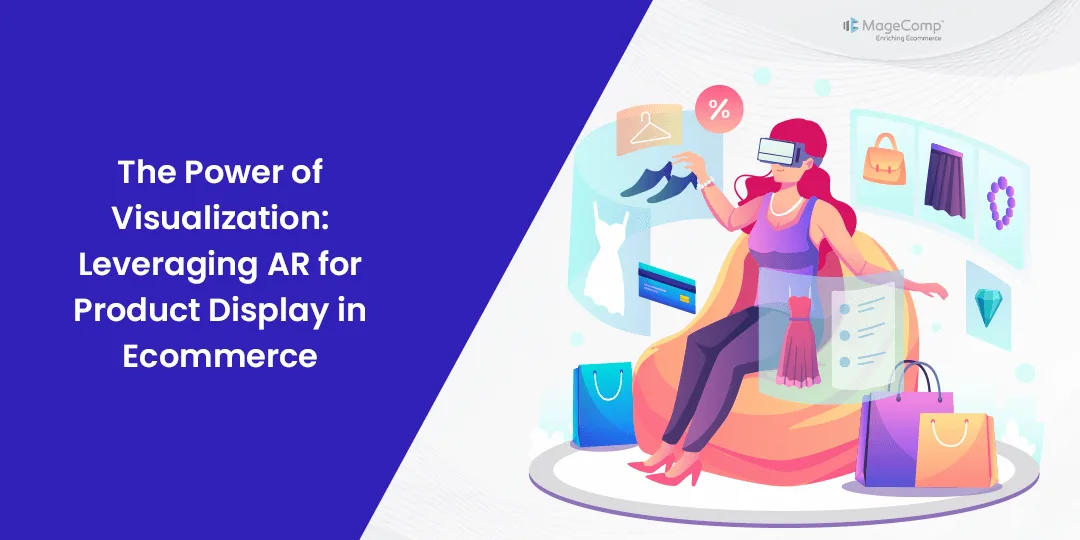In today’s digital era, the realm of ecommerce continues to evolve, constantly seeking innovative ways to enhance the online shopping experience. Among the latest advancements is Augmented Reality (AR), a technology that overlays digital information onto the real world, revolutionizing the way consumers interact with products online. AR holds immense potential for ecommerce, particularly in product visualization, offering benefits that redefine the shopping journey.
What is Augmented Reality?
Augmented Reality (AR) bridges the gap between the physical and digital worlds by superimposing computer-generated images onto a user’s view of the real world. Unlike Virtual Reality (VR), which creates an entirely immersive digital environment, AR enhances the existing environment with virtual elements. This technology is often accessed through smartphones, tablets, or AR glasses, allowing users to experience a blended reality where digital and physical elements coexist.
Benefits of AR for eCommerce
Augmented Reality (AR) offers numerous benefits for ecommerce, transforming the way consumers shop online and revolutionizing the retail landscape. Here are some key advantages of incorporating AR into ecommerce platforms:
Enhanced Product Visualization:
AR enables customers to visualize products in their own environment, offering a more realistic and immersive shopping experience compared to static images or videos. By superimposing digital representations of products onto the real world, AR allows shoppers to see how items will look and fit before making a purchase, reducing uncertainty and increasing confidence in their buying decisions.
Reduced Returns:
One of the most significant challenges in ecommerce is the issue of returns, particularly due to discrepancies between customers’ expectations and the actual appearance or fit of products. AR addresses this challenge by allowing customers to virtually try products before purchasing, minimizing the likelihood of returns caused by dissatisfaction. By providing a more accurate representation of products, AR helps retailers reduce return rates and associated costs, improving overall efficiency and profitability.
Increased Engagement:
Interactive AR experiences capture users’ attention and encourage prolonged engagement with the brand. By offering immersive and personalized shopping experiences, AR drives higher levels of customer engagement, leading to increased time spent on ecommerce platforms and higher conversion rates. AR-powered features such as virtual try-ons, product customizations, and interactive product demonstrations create memorable interactions that resonate with customers, fostering stronger brand loyalty and advocacy.
Personalized Shopping:
AR can be customized to tailor product recommendations and visualizations based on individual preferences, creating a personalized shopping journey for each customer. By analyzing user data and behavior, ecommerce platforms can leverage AR technology to deliver targeted and relevant product suggestions, enhancing the overall shopping experience and driving higher levels of customer satisfaction and loyalty.
Brand Differentiation:
Adopting AR sets brands apart from competitors, signaling innovation and a commitment to providing cutting-edge shopping experiences. By offering unique and immersive AR-powered features, retailers can differentiate their brand in a crowded marketplace, attracting new customers and retaining existing ones. AR enhances brand perception and strengthens customer relationships, positioning businesses as leaders in the ecommerce landscape and driving long-term growth and success.
Improved Marketing and Sales:
AR can be leveraged not only for product visualization but also for marketing and sales initiatives. Interactive AR experiences, such as virtual try-ons, product demonstrations, and immersive storytelling, can be used to create compelling marketing campaigns that drive brand awareness and customer engagement. By integrating AR into marketing strategies, retailers can capture the attention of consumers and drive conversions, ultimately driving revenue and business growth.
Advantages of AR for Product Visualization
Augmented Reality (AR) presents a plethora of advantages for product visualization, revolutionizing the way consumers interact with products online and offering numerous benefits for both businesses and customers. Here are some key advantages of leveraging AR for product visualization:
Realistic Preview:
AR provides consumers with a highly realistic preview of products in their own environment. By superimposing virtual representations of products onto the real world, AR enables customers to visualize how items will look and fit in their homes or spaces, offering a more accurate representation than traditional product images or videos. This realistic preview enhances the shopping experience, reduces uncertainty, and increases confidence in purchasing decisions.
Interactive Engagement:
AR facilitates interactive engagement with products, allowing users to actively explore and interact with virtual representations in real-time. Through gestures, taps, and swipes, consumers can rotate, resize, and manipulate virtual objects, gaining a deeper understanding of product features, functionality, and design. This interactive experience captivates users’ attention, fosters engagement, and encourages prolonged interaction with products, ultimately driving higher conversion rates and customer satisfaction.
Improved Decision-Making:
By providing consumers with a more comprehensive understanding of products, AR facilitates informed decision-making. With access to detailed product information, specifications, and visualizations, customers can make more confident and informed purchase decisions, leading to higher levels of satisfaction and reduced likelihood of returns. AR empowers consumers to evaluate products more effectively, ensuring that they select items that meet their needs, preferences, and expectations.
Customization Options:
AR enables retailers to offer customizable product experiences, allowing consumers to personalize and tailor products according to their preferences. Whether choosing different colors, styles, or configurations, users can visualize various options in real-time, ensuring that they find the perfect match for their individual tastes and requirements. This customization capability enhances customer satisfaction, fosters brand loyalty, and differentiates retailers from competitors in the market.
Reduced Returns:
One of the significant challenges in ecommerce is the issue of returns, often stemming from discrepancies between customers’ expectations and the actual appearance or fit of products. AR addresses this challenge by providing a more accurate representation of products, thereby minimizing the likelihood of returns caused by dissatisfaction. By allowing customers to virtually try products before purchasing, AR reduces uncertainty and ensures that shoppers are satisfied with their purchases, ultimately decreasing return rates and associated costs for retailers.
Enhanced Brand Perception:
Adopting AR for product visualization enhances brand perception and reinforces a retailer’s reputation for innovation and customer-centricity. By offering immersive and interactive shopping experiences, brands can differentiate themselves from competitors, capture consumers’ attention, and leave a lasting impression. AR-powered product visualizations create memorable interactions that resonate with customers, fostering stronger brand loyalty and advocacy in the long run.
Ways to Enhance Product Visualization Using AR
Enhancing product visualization using Augmented Reality (AR) involves leveraging innovative strategies and technologies to create immersive and engaging experiences for consumers. Here are several effective ways to enhance product visualization using AR:
High-Quality 3D Models:
Invest in high-fidelity 3D models of products to ensure accurate representation and realistic rendering in AR environments. High-quality models enhance the visual appeal of products and create a more immersive experience for users, increasing engagement and satisfaction.
Checkout – Best Shopify 3D Product Image Apps
Interactive Product Demonstrations:
Use AR to create interactive product demonstrations that allow users to explore features, functionality, and usage in real-time. Enable users to interact with virtual elements, such as buttons, sliders, and switches, to simulate the product experience and provide a deeper understanding of its capabilities.
Virtual Try-Ons:
Implement virtual try-on experiences for products such as clothing, eyewear, and cosmetics, allowing users to visualize how items will look on themselves before making a purchase. Enable users to see themselves in real-time through their device’s camera and try different styles, sizes, and colors to find the perfect fit.
Contextual Visualization:
Enable users to visualize products in their intended context or environment using AR. Allow users to place virtual furniture in their living room, visualize artwork on their walls, or see how appliances will fit in their kitchen. Contextual visualization provides users with a better sense of scale, proportion, and aesthetics, helping them make more informed purchasing decisions.
Customization Options:
Offer customization features that allow users to personalize products according to their preferences using AR. Enable users to customize colors, patterns, materials, and other design elements in real-time, providing a sense of ownership and uniqueness. Customization options enhance user engagement, satisfaction, and perceived value.
Augmented Product Information:
Overlay relevant product information, specifications, and reviews onto AR visualizations to provide users with additional context and insights. Enable users to access detailed product descriptions, technical specifications, customer reviews, and ratings directly within the AR experience, empowering them to make informed decisions.
Social Sharing and Collaboration:
Enable users to share AR visualizations with friends, family, or colleagues through social media or messaging platforms. Facilitate collaborative decision-making by allowing users to invite others to view and interact with AR visualizations together in real-time. Social sharing and collaboration features extend the reach of AR experiences and drive engagement through word-of-mouth recommendations.
Multi-Platform Support:
Ensure compatibility with a wide range of devices and platforms, including smartphones, tablets, and AR-enabled browsers, to reach a broader audience. Optimize AR experiences for different screen sizes, resolutions, and input methods to deliver consistent and seamless experiences across devices.
Gamification Elements:
Incorporate gamification elements into AR experiences to make product visualization more interactive and entertaining. Add challenges, rewards, and achievements to encourage user engagement and participation. Gamification elements can increase user motivation, retention, and satisfaction, enhancing the overall shopping experience.
Continuous Improvement:
Continuously iterate and improve AR experiences based on user feedback, analytics, and emerging technologies. Stay abreast of advancements in AR technology, such as improved tracking, rendering, and interaction capabilities, to enhance the realism and effectiveness of product visualization. Regularly update content, features, and functionalities to keep AR experiences fresh, relevant, and compelling.
Final Thoughts
Augmented Reality presents a transformative opportunity for ecommerce, particularly in the realm of product visualization. By leveraging AR technology, retailers can offer immersive, interactive, and personalized experiences that elevate the online shopping journey, driving engagement, conversion, and brand loyalty in the digital marketplace. As AR continues to evolve and become more accessible, its integration into ecommerce platforms will undoubtedly shape the future of online retail, empowering both consumers and businesses alike.












